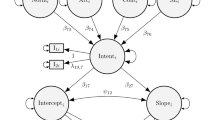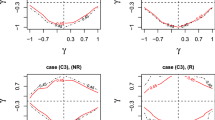Abstract
A method is presented for marginal maximum likelihood estimation of the nonlinear random coefficient model when the response function has some linear parameters. This is done by writing the marginal distribution of the repeated measures as a conditional distribution of the response given the nonlinear random effects. The resulting distribution then requires an integral equation that is of dimension equal to the number of nonlinear terms. For nonlinear functions that have linear coefficients, the improvement in computational speed and accuracy using the new algorithm can be dramatic. An illustration of the method with repeated measures data from a learning experiment is presented.
Similar content being viewed by others
References
Bates, D.M., & Watts, D.G. (1988). Nonlinear regression analysis and its applications. New York: Wiley.
Davidian, M., & Giltinan, D.M. (1995). Nonlinear models for repeated measurement data. London: Chapman & Hall.
Demidenko, E. (1997). Asymptotic properties of nonlinear mixed-effects models. In T.G. Gregoire, D.R. Brillinger, P.J. Diggle, E. Russek-Cohen, W.G. Warrne, & R.D. Wolfinger (Eds.), Modelling longitudinal and spatially correlated data: Methods, applications and future directions (pp. 49–62). New York: Springer.
du Toit, S.H.C. (1993). Analysis of multilevel models. Part 1: Theoretical aspects. Pretoria: Human Sciences Research Council.
Dyba, T., Hakulinen, T., & Päivärinta, L. (1997). A simple non-linear model in incidence prediction. Statistics in Medicine, 16, 2297–2309.
Evans, M., & Swartz, T. (1995). Methods for approximating integrals in statistics with special emphasis on Bayesian integration problems. Statistical Science, 10, 254–272.
Fitzmaurice, G., Laird, N., & Ware, J. (2004). Applied longitudinal analysis. New York: Wiley.
Frensch, P.A., Lindenberger, U., & Kray, J. (1999). Imposing structure on an unstructured environment: Ontogenetic changes in the ability to form rules of behavior under conditions of low environmental predictability. In A.D. Friederici, & R. Menzel (Eds.), Learning: Rule extraction and representation (pp. 139–162). Berlin: de Gruyter.
Hand, D.J., & Crowder, M.J. (1996). Practical longitudinal data analysis. London: Chapman & Hall.
Krommer, A.R., & Ueberhuber, C.W. (1994). Numerical integration on advanced computer systems. New York: Springer.
Lawton, W.H., & Sylvestre, E.A. (1971). Elimination of linear parameters in nonlinear regression. Technometrics, 13, 461–467.
Lindstrom, M.J., & Bates, D.M. (1990). Nonlinear mixed effects models for repeated measures data. Biometrics, 46, 673–687.
MacCallum, R.C., Kim, C., Malarkey, W., & Kielcolt-Glaser, J. (1997). Studying multivariate change using multilevel models and latent curve models. Multivariate Behavioral Research, 32, 215–253.
Meredith, W., & Tisak, J. (1990). Latent curve analysis. Psychometrika, 55, 107–122.
Pinheiro, J.C., & Bates, D.M. (1995). Approximations to the loglikelihood function in the nonlinear mixed effects model. Journal of Computational and Graphical Statistics, 4, 12–35.
Richards, F.S.G. (1961). A method of maximum-likelihood estimation. Journal of the Royal Statistical Society (B), 23, 469–476.
Roe, D.J. (1997). Comparison of population pharmacokinetic modeling methods using simulated data: Results from the population modeling workgroup (with discussion). Statistics in Medicine, 16, 1241–1262.
Ross, G.J.S. (1970). The efficient use of function minimization in non-linear maximum-likelihood estimation. Applied Statistics, 19, 205–221.
Ross, G.J.S. (1990). Nonlinear estimation. New York: Springer.
Rubin, D.C., Hinton, S., & Wenzel, A. (1999). The precise time course of retention. Journal of Experimental Psychology: Learning, Memory and Cognition, 25, 1161–1176.
Rubin, D.C., & Wenzel, A. (1996). One hundred years of forgetting: A quantitative description of retention. Psychological Review, 103, 734–760.
Sargisson, R.J., & White, K.G. (2001). Generalization of delayed matching to sample following training at different delays. Journal of the Experimental Analysis of Behavior, 75, 1–14.
Stroud, A.H., & Secrest, D. (1966). Gaussian quadrature formulas. New York: Prentice-Hall.
Vonesh, E.F. (1992). Non-linear models for the analysis of longitudinal data. Statistics in Medicine, 11, 1929–1954.
Vonesh, E.F., & Chinchilli, V.M. (1997). Linear and nonlinear models for the analysis of repeated measurements. New York: Dekker.
Vonesh, E.F., Wang, H., Nie, L., & Majumdar, D. (2002). Conditional second-order generalized estimating equations for generalized linear and nonlinear mixed-effects models. Journal of the American Statistical Association, 97, 271–283.
Walker, S. (1996). An EM algorithm for nonlinear random effects models. Biometrics, 52, 934–944.
Willet, J.B., & Sayer, A.G. (1994). Using covariance structure analysis to detect correlates and predictors of individual change over time. Psychological Bulletin, 116, 363–381.
Zeger, S.L., Liang, K.-Y., & Albert, P.S. (1988). Models for longitudinal data: A generalized estimating equation approach. Biometrics, 44, 1049–1060.
Author information
Authors and Affiliations
Corresponding author
Rights and permissions
About this article
Cite this article
du Toit, S.H.C., Cudeck, R. Estimation of the Nonlinear Random Coefficient Model when Some Random Effects Are Separable. Psychometrika 74, 65–82 (2009). https://doi.org/10.1007/s11336-008-9107-7
Received:
Revised:
Published:
Issue Date:
DOI: https://doi.org/10.1007/s11336-008-9107-7




